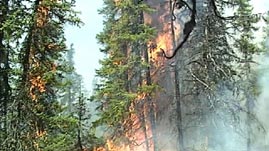Teachers' Domain - Digital Media for the Classroom and Professional Development
User: Preview

Source: Arctic Athabaskan Council, NASA, and NASA/USGS.



This video adapted from the Arctic Athabaskan Council highlights the effects that global warming is having on the Arctic landscape. Melting permafrost, increased erosion, and dying trees are presented as evidence that Earth's northernmost region is on the front line of climate change. The consequences of warming are varied, complex, and interrelated. For example, the video details how warmer temperatures lead to larger insect populations, which feed on leaves and bark and ultimately kill trees. As trees die, they lose their capacity to absorb water, as well as to hold the soil through their root systems. This leads to increased surface runoff and erosion, and creates tinder for forest fires.
To truly understand environmental changes and their global implications, we must first seek to identify the complex linkages and feedback processes that exist between Earth's four principal components—the atmosphere (air), lithosphere (land), hydrosphere (water, along with ice and snow referred to as the cryosphere), and biosphere (life). Changes in climate result in a cascade of changes in the Earth system, with consequences for human societies. For example, as the Arctic climate warms, glacial recession is prompting sea levels to rise, and warmer temperatures are prompting devastating insect infestations that kill trees and lead to an increased incidence of forest fires.
No less consequential is the melting of the permanently frozen ground called permafrost. Permafrost consists of large cavities of pure ice and ground ice, or ice that forms in pore spaces and bonds sediments in the soil. About a quarter of the northern hemisphere's land, including most Arctic land, contains permafrost. Although these regions have been in the permafrost zone for thousands of years, today, all regions are reporting thawing and a decrease in permafrost. As with polar ice sheets and sea ice, which have been melting at accelerated rates over the past half-century, scientists attribute melting permafrost to increased atmospheric warming.
According to estimates, by the mid-21st century, the area of permafrost in the northern hemisphere is expected to decline by 20 to 35 percent. The depth of thawing is likely to increase as well. While the deeper permafrost layer remains frozen, the active upper layer responds dramatically to changes in climate, thawing further downward as surface air temperatures rise.
Thawing of permafrost is already having dramatic effects. Much of the Arctic is desert, characterized by little or infrequent rainfall, extreme temperatures, sparse vegetation, and poor drainage. When permafrost thaws, meltwater runoff erodes the surface and deposits sediments into rivers and, ultimately, the Arctic Ocean. Increased sedimentation in the rivers and oceans is likely to impact both freshwater and marine biodiversity. Melting permafrost is also the likely cause behind the disappearance of Arctic lakes, as water fills the pore spaces vacated by ice in surrounding soils. Where people have built structures atop permafrost, or dug into the permafrost to create ice cellars for food preservation, thawing has caused buildings to sink or collapse—again because ice has left open pore spaces in the soil, which can no longer support as much weight. The cost of rebuilding or relocating entire communities could run into the tens of millions of dollars.
Apart from altering local ecosystems and communities, melting permafrost will most likely have a major influence on global climate. Thawing threatens to release into the atmosphere vast amounts of organic carbon frozen in the soil. In drier areas, carbon takes the form of carbon dioxide, and in wetter ones, methane. Release of stored carbon in the form of these two important greenhouse gases would only serve to accelerate global warming.
 Loading Standards
Loading Standards Teachers' Domain is proud to be a Pathways portal to the National Science Digital Library.
Teachers' Domain is proud to be a Pathways portal to the National Science Digital Library.
